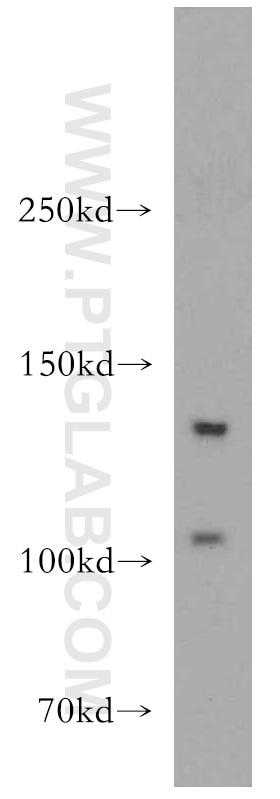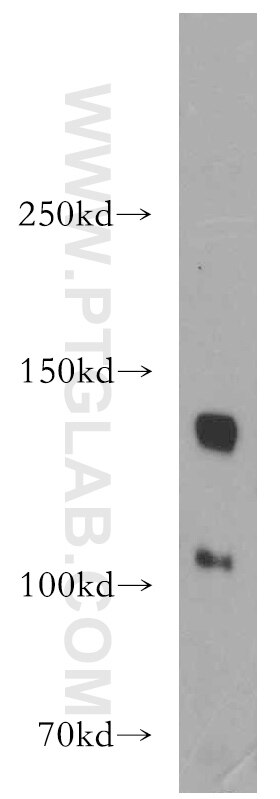Validation Data Gallery
Tested Applications
| Positive WB detected in | A549 cells, A431 cells |
Recommended dilution
| Application | Dilution |
|---|---|
| Western Blot (WB) | WB : 1:500-1:2000 |
| It is recommended that this reagent should be titrated in each testing system to obtain optimal results. | |
| Sample-dependent, Check data in validation data gallery. | |
Published Applications
| KD/KO | See 2 publications below |
| WB | See 5 publications below |
| IHC | See 2 publications below |
| IF | See 1 publications below |
Product Information
20000-1-AP targets TGFBR3-Specific in WB, IHC, IF, ELISA applications and shows reactivity with human samples.
| Tested Reactivity | human |
| Cited Reactivity | human, mouse, goat |
| Host / Isotype | Rabbit / IgG |
| Class | Polyclonal |
| Type | Antibody |
| Immunogen |
Peptide 相同性解析による交差性が予測される生物種 |
| Full Name | transforming growth factor, beta receptor III |
| Calculated molecular weight | 93 kDa |
| Observed molecular weight | 110-150 kDa |
| GenBank accession number | NM_003243 |
| Gene Symbol | TGFBR3 |
| Gene ID (NCBI) | 7049 |
| RRID | AB_10664930 |
| Conjugate | Unconjugated |
| Form | |
| Form | Liquid |
| Purification Method | Antigen affinity purification |
| UNIPROT ID | Q03167 |
| Storage Buffer | PBS with 0.02% sodium azide and 50% glycerol{{ptg:BufferTemp}}7.3 |
| Storage Conditions | Store at -20°C. Stable for one year after shipment. Aliquoting is unnecessary for -20oC storage. |
Background Information
Transforming growth factor β (TGF-β) is a multifunctional cytokine that plays important roles in normal development and homeostasis (PMID: 8530052). There are three TGF-β forms: TGF-β1, TGF-β2, and TGF-β3. The diverse effects of TGF-β are mediated by the TGF-β receptors and cell surface-binding proteins. Three TGF-beta receptors exist: TGFBR1, TFGBR2, TGFBR3 (PMID: 8530052; 30184463). TGFBR3, also known as betaglycan, is a transmembrane proteoglycan that often functions as a co-receptor with other TGF-beta receptor superfamily members. In addition to the transmembrane form, the extracellular domain of TGFBR3 can be cleaved to a soluble form (sTGFBR3), which may serve as an antagonist of TGF-β to inhibit TGF-β signaling (PMID: 30184463). TGFBR3 has a larger apparent molecular weight than the calculated molecular weight, due to extensive carbohydrate modifications (PMID: 1556106). This antibody is specific to TGFBR3.
Protocols
| Product Specific Protocols | |
|---|---|
| WB protocol for TGFBR3-Specific antibody 20000-1-AP | Download protocol |
| Standard Protocols | |
|---|---|
| Click here to view our Standard Protocols |
Publications
| Species | Application | Title |
|---|---|---|
Cancer Res Osteoblast-secreted factors mediate dormancy of metastatic prostate cancer in the bone via activation of the TGFβRIII-p38MAPK-pS249/T252RB pathway.
| ||
Cell Prolif Spatially multicellular variability of intervertebral disc degeneration by comparative single-cell analysis | ||
Int Immunopharmacol Vitamin D3 alleviates pulmonary fibrosis by regulating the MAPK pathway via targeting PSAT1 expression in vivo and in vitro. | ||
Mol Cell Endocrinol The miR-103a-3p/TGFBR3 axis regulates TGF-β-induced orbital fibroblast activation and fibrosis in thyroid-eye disease
| ||
bioRxiv Spatial patterning of fibroblast TGFβ signaling underlies treatment resistance in rheumatoid arthritis | ||
Biochem Biophys Res Commun CUL4B enhances the malignant phenotype of esophageal squamous cell carcinoma by suppressing TGFBR3 expression |


